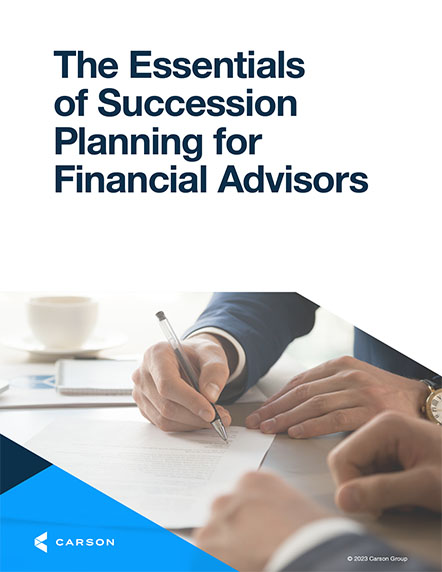There has never been a better time for advisor-CEOs to explore growing their business through M&A. Two key trends are fueling opportunities for significant growth — if you’re ready to take your business to the next level.
The first trend changing the RIA landscape is the demographic shift taking hold as baby boomers transition out of the workforce. In the financial advisory space, where the average age of an advisor is 55, there aren’t enough new advisors entering the field to replace those retiring.
According to research from Cerulli Associates, 37% of financial advisors who collectively oversee $10.4 trillion – or 40% of total industry assets – are expected to retire within the next 10 years. Of this group, one in four does not have a succession plan for their business. Without second-generation advisors in place who can take over, aging advisors are looking for younger buyers to support their longtime clients. M&A is emerging as a key part of succession planning for financial advisors.
These circumstances combine to present a powerful opportunity for financial advisors on the road to growth.
The second key trend is the sharp increase in how much practices are worth, thanks to the growing amount of private equity entering the RIA space. McKinsey reports that valuations are 40% higher than they were five years ago, and this has not hampered sales. In fact, deal volumes for wealth management and investment management increased by 50% in 2021, according to Deloitte.
How do you know if M&A is the right path to growth? Take a close look at your operations. Do you have a healthy cash flow and capital position, and are you able to access funding? Are you at or close to 100% client retention? Do you have the people and technology infrastructure in place to take on additional clients? Unlike organic growth, M&A growth is explosive, often adding hundreds of clients over a period of two or three months.
Once you’ve determined M&A is worth exploring, how to buy a financial advisor book of business comes down to answering three essential questions.
What is Your Vision?
Start with a business plan. Spell out your mission and vision statement, who you are as an organization, your investment philosophy, the characteristics of your ideal client, your service offering and strategic goals. Once you have this clear understanding, you can think about the steps necessary to achieve your goals.
For example, do you want to get to $1 billion in assets under management, 1,000 clients and build a firm that will carry on your legacy? Or do you want to generate a solid income to provide for your family by helping people in your community retire comfortably? These are two different endgames that require different strategies. While M&A could make sense for the former, it may not for the latter.
Who is Your Ideal Advisor?
Once you’ve established long-term goals and the type of advisory business you are building, it’s much easier to evaluate whether a prospective firm is the right fit both from a quantitative and qualitative perspective. When it comes to quantitative metrics, it’s important to consider a prospective acquisition’s assets under management, expected return on investment, client base, service offering and how these factors align with your strategic goals and existing business.
The qualitative metrics are more difficult to assess, but critical to ensuring the success of a merger or acquisition. This comes down to determining if the advisor and their firm are a good cultural fit. Ask yourself these questions:
- Do you share a similar investment philosophy?
- Are you going to enjoy working with the advisor and their clients?
- Will the advisor be a good ambassador for your brand?
Acquiring a firm with a different investment philosophy, client base or product offering and trying to fit that into your business could negatively impact the service you provide to your existing clients.
Understanding the values and behaviors that drive success in your firm is the first step to evaluating whether you will be able to successfully integrate with a prospective external partner.
As a leader, take a close look at how your organization does things and survey your team about the current state of the company culture. Ask your potential partner to do the same with their team to identify their unique culture. Together, look for similarities and differences. This will help you determine if you can move forward together. If the answer is yes, make building a cohesive culture a priority as you take the steps to combine the businesses. Your success could depend on it.
What is Your Ideal Deal Structure?
Arriving at the right deal structure requires balancing the goals of the buyer and seller. Focus negotiations on how the purchase price will be paid and over what period of time. For the buyer, deciding on the ideal deal structure depends on how your business is currently structured.
Here are three common M&A deal structures:
W-2 (wage and tax statement)
This involves bringing new advisors on as employees and paying them a wage. It is the most valuable type of business structure because all of the clients belong to the practice, not to an individual advisor.
When a W-2 approach makes sense: When the strategic vision is to build an ensemble practice and scale it.
1099 (information forms to report non-employee income)
In this case, each advisor is an independent contractor and owns their book of business. They can take their clients with them when they leave.
When a 1099 approach makes sense: When the goal is to share expenses and increase the areas of expertise within a practice.
Equity partnership
New advisors receive an ownership stake in the practice.
When an equity partnership approach makes sense: When you are purchasing a book of business and the advisor is going to stay long term – i.e., more than five years – to help with the transition. Offering equity in the new enterprise will incentivize them to help you grow the overall business.
Read more: An Overview to Buying and Selling a Financial Advisor Book of Business
Protecting Your Most Valuable Asset Through M&A
Answering the three questions presented here will help you mitigate risk and protect your most valuable asset: your existing clients and book of business. Understanding your values and your vision will help you determine the advisors and business structure that will help you work toward your goals. If, as an independent advisor, you aren’t exploring a potential acquisition, you could be leaving a critical growth strategy on the table.
It’s critical to do your due diligence when you engage in M&A. Carson’s experienced M&A team helps our partner firms acquire for succession and growth. Let’s talk about how we could support you during a quick and confidential conversation.


